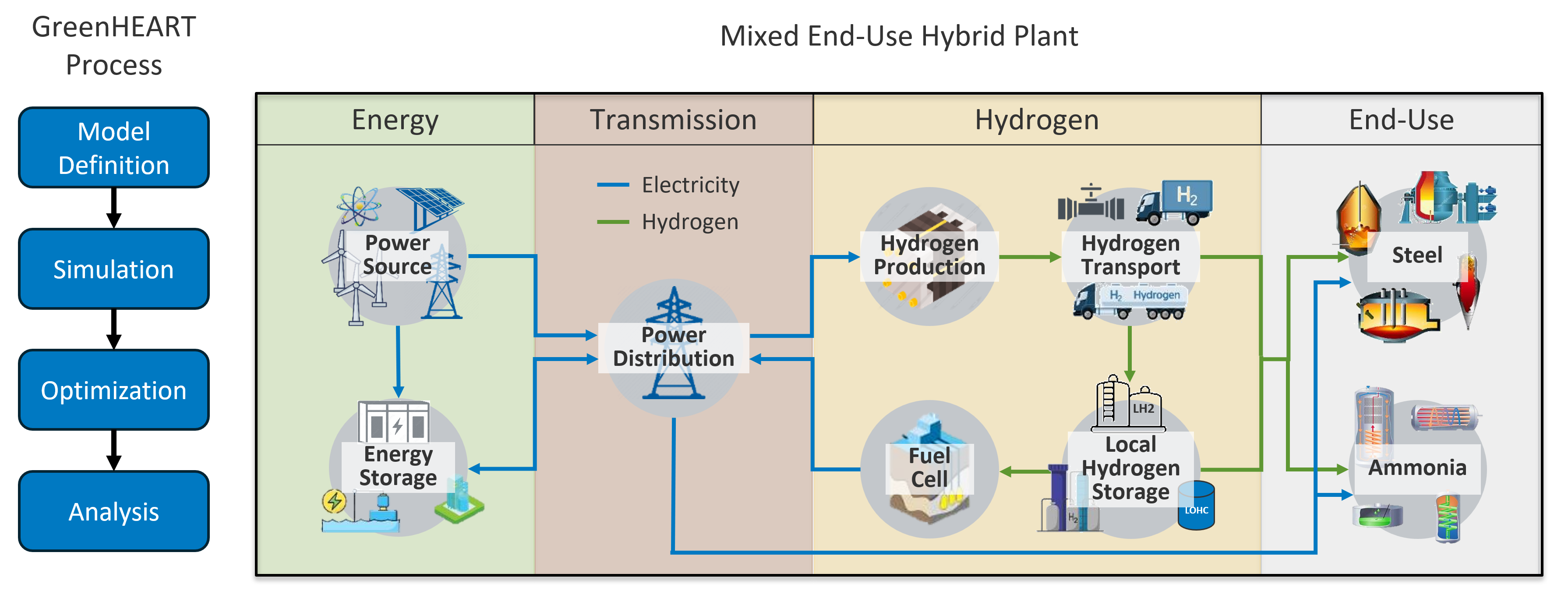H2Integrate - Holistic Hybrids Optimization and Design Tool#
H2Integrate is an open-source Python package for modeling and designing hybrid energy systems producing electricity, hydrogen, ammonia, steel, and other products.
Note
H2Integrate is under active development and may be missing features that existed in previous versions. H2Integrate v0.2.0 is the last version that uses the prior framework.
If you use this software in your work, please cite using the following BibTeX:
@software{brunik_2025_17903150,
author = {Brunik, Kaitlin and
Grant, Elenya and
Thomas, Jared and
Starke, Genevieve M and
Martin, Jonathan and
Ramos, Dakota and
Koleva, Mariya and
Reznicek, Evan and
Hammond, Rob and
Stanislawski, Brooke and
Kiefer, Charlie and
Irmas, Cameron and
Vijayshankar, Sanjana and
Riccobono, Nicholas and
Frontin, Cory and
Clark, Caitlyn and
Barker, Aaron and
Gupta, Abhineet and
Kee, Benjamin (Jamie) and
King, Jennifer and
Jasa, John and
Bay, Christopher},
title = {H2Integrate: Holistic Hybrids Optimization and Design Tool},
month = dec,
year = 2025,
publisher = {Zenodo},
version = {0.4.0},
doi = {10.5281/zenodo.17903150},
url = {https://doi.org/10.5281/zenodo.17903150},
}
What is H2Integrate?#
H2Integrate is designed to be flexible and extensible, allowing users to create their own components and models for various energy systems. The tool currently includes renewable energy generation (wind, solar, wave, tidal), battery storage, hydrogen, ammonia, methanol, and steel technologies. Other elements such as desalination systems, pipelines, compressors, and storage systems can also be included as developed by users. Some modeling capabilities in H2Integrate are provided by integrating existing tools, such as HOPP, PySAM, ORBIT, and ProFAST. The H2Integrate tool is built on top of NASA's OpenMDAO framework, which provides a powerful and flexible environment for modeling and optimization.
Note
H2Integrate was previously known as GreenHEART. The name was updated to H2Integrate to better reflect its expanded capabilities and focus on integrated energy systems.
How does H2Integrate work?#
H2Integrate models energy systems on a yearly basis using hourly timesteps (i.e., 8760 operational data points across a year). Results from these simulations are then processed across the project's lifecycle to provide insights into the system's performance, costs, and financial viability. Depending on the models used and the size of the system, H2Integrate can simulate systems ranging from the kW to GW scale in seconds on a personal computer. Additionally, H2Integrate tracks the flow of electricity, molecules (e.g., hydrogen, ammonia, methanol), and other products (e.g., steel) between different technologies in the energy system.
H2Integrate models hybrid energy systems by:
Generating electricity output profiles from renewable energy sources (e.g., wind, solar, hydro) and storage systems (e.g., batteries, pumped hydro, vanadium flow batteries)
Modeling the performance of hydrogen electrolyzers, steel furnaces, methanol plants, or ammonia synthesis systems using the generated electricity profiles
Performing techno-economic analysis of the system to evaluate its costs and financial viability
This process is shown for an example energy system in the figure below:

How does H2Integrate differ from other tools?#
H2Integrate is developed at NREL, which has a long history of developing high-quality tools for renewable energy systems. Although there are many tools available for modeling hybrid energy systems, H2Integrate is unique in its focus on component-level modeling and design including nonlinear physics models, as well as its modularity and extensibility. H2Integrate stands out by offering a modular approach that models the entire energy system, from generation to end-use products such as hydrogen, ammonia, methanol, and steel, which is a capability not commonly found in other tools.
REopt is similar to H2Integrate in that it models hybrid energy systems, though it is a higher-level tool that focuses on linear optimization. One significant difference is that REopt can accommodate various external loads such as steel or ammonia, as long as the user provides the load profiles for those end-uses. H2Integrate models the processes themselves and does not require the user to provide a load profile, instead modeling what the load profile would be based on physics-based or analytical models.
SAM is another relevant tool (that H2Integrate partially uses), which gives more detailed performance and financial modeling capabilities than REopt. Like REopt, SAM also does not model loads or end-uses but accepts timeseries data of the loads for design purposes.
H2Integrate goes into more component-level details than those tools, especially in terms of nonlinear physics-based modeling and design.
User Guide
Technology Models
- Feedstock Models
- Run-of-river hydropower model
- Natural gas power plant model
- WOMBAT Electrolyzer O&M Model
- Solar-PV model using Pvwattsv8 module in PySAM
- Wind Plant model using Windpower module in PySAM
- Solar-PV Cost Models based on ATB-Formatted Cost Data
- Wind Cost Model based on ATB-Formatted Cost Data
- Marine Carbon Dioxide Capture Models
- Simple Generic Storage Model
- Methanol model
- Ammonia model
- PySAM Battery Model
- Geologic Hydrogen Models
- Grid Performance and Cost Models
- Bulk Hydrogen Storage Cost Model
Resource Models
Finance Models
Developer Guide
Miscellaneous Resources
API Reference
- API Documentation
- h2integrate.core
- h2integrate.core.dict_utils
- h2integrate.core.feedstocks
- h2integrate.core.h2integrate_model
- h2integrate.core.model_baseclasses
- h2integrate.core.pose_optimization
- h2integrate.core.resource_summer
- h2integrate.core.supported_models
- h2integrate.core.test
- h2integrate.core.utilities
- h2integrate.core.validators
- h2integrate.converters
- h2integrate.converters.ammonia
- h2integrate.converters.co2
- h2integrate.converters.grid
- h2integrate.converters.hopp
- h2integrate.converters.hydrogen
- h2integrate.converters.iron
- h2integrate.converters.methanol
- h2integrate.converters.natural_gas
- h2integrate.converters.nitrogen
- h2integrate.converters.solar
- h2integrate.converters.steel
- h2integrate.converters.test
- h2integrate.converters.wind
- h2integrate.control
- h2integrate.finances
- h2integrate.resource
- h2integrate.storage
- h2integrate.transporters
- h2integrate.tools
- h2integrate.core

